
Top 25 Rankings 1901-1935
1924 National Championship
Home
1924
College Football Top 25
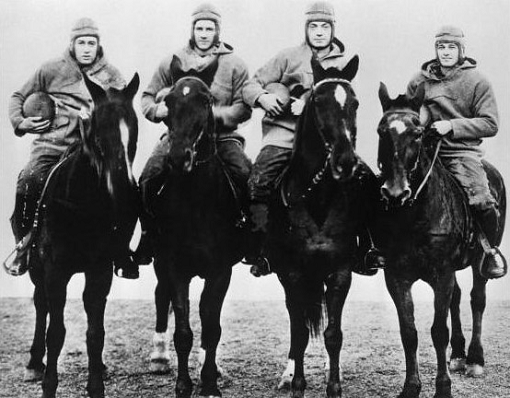
Pictured
above are the legendary Four Horsemen of Notre Dame. This was the
season Notre Dame became NOTRE DAME. I covered them in great
detail in my 1924 national championship article.
They are a unanimous selection as 1924 MNC, and they would have been a
landslide #1 had there been an AP poll in 1924. So on to #2...
California and Yale
The next 2 teams in a 1924 AP poll are pretty easy to pick out as well: 8-0-2 California and 6-0-2 Yale, in that order.
California had not taken a loss since 1919, riding the 2nd longest
unbeaten streak in college football history. They took ties at 8-1-1
Washington (will be #14) and to 7-1-1 Stanford (#4), but they won 7-0
over 9-2 Southern Cal (#7), 17-7 over 8-1 St. Mary's (#6), and 14-0
over 9-1-1 Penn (#9), the best 3 wins by any team this season. Stanford
went to the Rose Bowl because Cal tied Washington, but Stanford did not
play Washington, or Southern Cal, or St. Mary's. The only other rated
team Stanford played at all was Notre Dame, who beat them 27-10 in the
Rose Bowl.
Yale took their ties to 7-0-1 Dartmouth (#4) and to 5-1-2 Army
(#8). Their schedule was not nearly as tough as Cal's, but they did win
7-6 over 7-3 Georgia (#26-30) and 10-0 at 4-2-1 Princeton (#19).
Dartmouth had a better straight record, but they did not play another ranked opponent aside from Yale. Yale
beat Brown 13-3, Dartmouth beat them 10-3, and Yale beat Harvard 19-6,
Dartmouth beat them 6-0.
California #2, Yale #3.
Dartmouth and Stanford
7-1-1 Stanford
lost to #1 Notre Dame in the Rose Bowl, but that outcome is irrelevant
when comparing them to 7-0-1 Dartmouth. As for the rest of their games,
these teams looked like twins. Stanford tied #2 Cal, and Dartmouth tied
#3 Yale. Neither team played any other top 25 caliber opponents, and
both had 2 close wins over unrated teams. No point in splitting hairs
beyond that: we'll place them in a tie.
Dartmouth and Stanford share the #4 slot.
St. Mary's (California) and Southern Cal
It was a
terrific year for the West Coast. California's "Wonder Teams" had been
dominating the region since 1920, but this year proved beyond a doubt
that West Coast football was more than just Cal.
Stanford hired
Hall of Fame coach Pop Warner away from Pittsburgh this season, and it
paid immediate dividends, as he took them to the Rose Bowl this season.
The one loss the rated teams from the West Coast took to an outside team this year was
Stanford's 27-10 drubbing by #1 Notre Dame in the Rose Bowl, but it
wasn't as bad as the score looks. Stanford outgained Notre Dame 316
yards to 186, though they also turned the ball over 8 times, 3 returned
for touchdowns.
On the same day, 8-0-2 California defeated 9-1-1
Penn (will be ranked #9) 14-0 at home. Southern Cal, who had been on the rise for a few years, beat 8-2-1 Syracuse
(#24) 16-0 on December 6th, and they beat 7-2 Missouri (#21) 20-7 on
Christmas Day. And finally, we have a "little big team" from the West Coast emerging this
season in 8-1 St. Mary's (California). They beat USC 14-10 on the road,
and would remain a strong football program until World War 2.
With their 2 big intersectional wins, a post-bowl poll would have
seen Southern Cal move into the top 10. St. Mary's, however, would have
been ranked more like #15, because they had no history, and at the time
they beat Southern Cal, the win gained relatively little national
attention. USC, after all, had a short football history themselves, and relatively little name value. Until
they beat 8-2-1 Syracuse and 7-2 Missouri to finish the season, that is. But 8-1
St. Mary's lost only to #2 Cal, and they beat 9-2 Southern Cal on the
road, so they should be rated ahead of USC.
The top candidates for #7 in a 1924 AP poll would have been 8-1
West Virginia, 6-1-1 Illinois, 5-1-2 Army, and 9-1-1 Penn. But none of
those teams should be rated ahead of 8-1 St. Mary's and 9-2 Southern
Cal. St. Mary's lost only to #2 Cal, and USC lost only to St. Mary's
and Cal. West Virginia lost to 5-3-1 Pittsburgh (#22). Illinois lost to
3-3-2 Minnesota (unranked) and they tied 4-1-3 Chicago (#23). Army was
a much better candidate, as they tied #3 Yale. But they also tied 5-3-1
Columbia (#25), and they did not beat any top 25 teams, while USC,
again, drubbed #21 Missouri and #24 Syracuse. And finally, Penn was
tied by 6-3-1 Penn State (unranked). They also lost 14-0 at Cal, where
St. Mary's lost by 10 and USC by 7.
St. Mary's #7, Southern Cal #8
Army, Pennsylvania, West Virginia, and Illinois
Now
we can bring
in this aforementioned foursome, and we'll place them in the order of their relevant records.
5-1-2 Army took an upset tie to 5-3-1 Columbia (#25), but they made up
for it with a tie to #3 Yale. 9-1-1 Penn did not thusly make up for
their upset tie to 6-3-1 Penn State (unrated), so Army was effectively
half a game better on the season. Army's loss came 13-7 to #1 Notre
Dame, Penn's 14-0 at #2 Cal. Army's best accomplishment, other than the
tie with #3 Yale, was a 14-7 win over 6-2-2 Florida (unranked). Penn's
big win came 6-3 over 7-2 Lafayette (#15).
8-1 West Virginia
took an upset loss at 5-3-1 Pittsburgh (#22), half a game worse than
Penn's upset tie, of course. And 6-1-1 Illinois took an upset loss at
3-3-2 Minnesota (unranked) and a tie at 4-1-3 Chicago (#23), rendering
them effectively half a game worse than West Virginia on the season.
Both amassed a pretty good collection of wins, though. West Virginia
beat 9-3 West Virginia Wesleyan (unranked), 6-3-1 Washington & Lee
(unranked), 5-1-1 Centre (#16), and 7-2 Washington & Jefferson
(#18). Illinois beat 5-3 Nebraska (#20), 6-2 Michigan (#13), and 6-1-1
Iowa (#12).
Illinois looked like a national championship caliber
team through their first 5 games, particularly in wins by 39-14 over
#13 Michigan and 36-0 over #11 Iowa, but they crashed badly in their
last 3 games, taking the upset tie, then the loss (by a score of 20-7
to an unranked team), then barely getting by 2-3-3 Ohio State 7-0 at
home in their finale.
Army #8, Pennsylvania #9, West Virginia #10, and Illinois #11.
Army
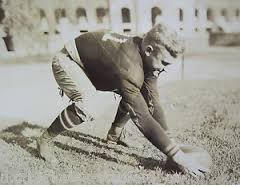 Army
was coached by John McEwan, a Hall of Fame center at Army 1913-1916,
during which time they had won 2 MNCs. He was also a good coach. He
went 18-5-3 here 1923-1925, 20-13-2 at Oregon 1926-1929, and 21-5-1 at
Holy Cross 1930-1932, for an overall record of 59-23-6.
Army
was coached by John McEwan, a Hall of Fame center at Army 1913-1916,
during which time they had won 2 MNCs. He was also a good coach. He
went 18-5-3 here 1923-1925, 20-13-2 at Oregon 1926-1929, and 21-5-1 at
Holy Cross 1930-1932, for an overall record of 59-23-6.
Army was
headlined on the field by another pair of Hall of Famers, both of whom
played at least 7 years of college football. Guard Edgar Garbisch
(pictured) played 4 years for Washington & Jefferson 1917-1920,
then another 4 at Army 1921-1924. He was captain at W&J in 1920,
and he was captain of this year's Army team. He was a consensus All
American at center in 1922, he was a nonconsensus AA at guard this
year, and he also served as the team's placekicker. In 1922 he kicked a
47 yard field goal to beat Navy 17-14, and this year he kicked 4 field
goals to beat them 12-0. He played against Notre Dame 5 times, once
with W&J and 4 times with Army, and he played all 60 minutes in all
5 games.
Halfback Harry "Light Horse" Wilson was the other Hall
of Famer with a long playing career. He played for Penn State
1921-1923, and was a consensus AA in 1923, then he played for Army
1924-1927. He would be a nonconsensus AA in 1926.
Guard August Farwick was a nonconsensus AA this season.
Penn
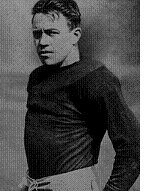 Penn
had been a football elite 1892-1910. Hall of Fame coach George Woodruff
went 124-15-2 there 1892-1901 and won 3 MNCs. He ranks very highly on the list for all-time
major/FBS coaching win percentage. After he retired, Penn was a top 10 caliber team
7 straight years 1904-1910 and won 2 more MNCs. Things dropped off a
bit in the next decade, but they were still a #11-20 type team
1911-1919. Then John Heisman arrived in 1920 to restore Penn to their
former glory. Except he didn't. He went 16-10-2 1920-1922, another step
backward. His assistant coach, Penn grad Lou Young, succeeded him and
improved matters, going 49-15-2 1923-1929. His best seasons were this
9-1-1 campaign, 7-1-1 in 1926, and 8-1 in 1928.
Penn
had been a football elite 1892-1910. Hall of Fame coach George Woodruff
went 124-15-2 there 1892-1901 and won 3 MNCs. He ranks very highly on the list for all-time
major/FBS coaching win percentage. After he retired, Penn was a top 10 caliber team
7 straight years 1904-1910 and won 2 more MNCs. Things dropped off a
bit in the next decade, but they were still a #11-20 type team
1911-1919. Then John Heisman arrived in 1920 to restore Penn to their
former glory. Except he didn't. He went 16-10-2 1920-1922, another step
backward. His assistant coach, Penn grad Lou Young, succeeded him and
improved matters, going 49-15-2 1923-1929. His best seasons were this
9-1-1 campaign, 7-1-1 in 1926, and 8-1 in 1928.
The star player
this season was Hall of Fame tackle Ed McGinley (pictured), a consensus
All American. End Clark Craig and guard Alton Papworth were
nonconsensus AA.
Penn would initially fall from top 25
contention after Lou Young retired as coach, but unlike their
counterparts now in the Ivy League, Penn would come roaring back in the
1940s for one more era of major football glory. This was the work of
Hall of Fame coach George Munger, who went 82-42-10 at Penn 1938-1953
while playing very rigorous schedules. Penn led the nation in
attendance 1938-1942 with 75,000 a game at Franklin Field. They
continued playing major football teams after the other Ivy League teams
had stopped, even when they could no longer win much. They went 0-3-1
against Notre Dame 1952-1955 and 1-6 against Penn State 1952-1958. In
1953, they played both of those teams, and also California, Oklahoma
State, Michigan, Army, Vanderbilt, and Navy. Munger then retired, and
they started to pull back from that kind of scheduling the next season.
Penn
finished ranked in the AP poll in 1940, 1941, 1945, 1946, and 1947, and
they made the fixed and expanded AP poll top 25 for 1944, 1950, and
1952. The last of the Ivy powerhouses.
Michigan and Iowa
Though Illinois
took an upset loss and tie, their relatively high rating is bolstered
by the huge scores they rolled up against the 2 best teams they played,
6-1-1 Iowa and 6-2 Michigan. Iowa took an upset tie to 2-3-3 Ohio
State, they were blasted by Illinois 36-0, and they didn't really beat
anybody this season... except Michigan, by a score of 9-2 on the road
in their finale. Michigan was similarly squashed by Illinois, 39-14,
and they didn't beat anyone of value at all this season, but at least
they didn't take an upset loss or tie. That last fact gives the
hypothetical AP poll voters of 1924 reason to rate Iowa and Michigan
this highly (as they would have), despite their weak schedules and
results.
Iowa #12, Michigan #13.
Washington, Lafayette, and Centre
I believe that a 1924 AP poll would have next ranked these 3 teams, and in this order: 8-1-1 Washington, 7-2 Lafayette, and 5-1-1 Centre. And it's logically viable, so that's the way we'll rank 'em here.
Washington took an upset loss at 4-2-3 Oregon (unranked), but they
tied #2 California. They beat no one of value, but the Cal tie was a
pretty big accomplishment. Lafayette took a huge
43-7 upset loss at 7-1-1 Rutgers (#26-30), but they beat 7-2 Washington
& Jefferson (#18), 5-3-1 Pittsburgh (#22), 4-1-3 Lehigh (#26-30),
and 8-2 Bucknell (unranked). Their other loss came by the slim score of
6-3 at #9 Penn. 7-1-1 Rutgers, by the way, lost to unrated Bucknell
(whom Lafayette beat 21-3), and they tied unrated Lehigh (whom
Lafayette beat 7-0).
As for Centre, the "small college" darling of the press since 1919,
this was their last season of relevance in college football. They lost
13-6 to #10 West Virginia in New York City, and they took a hyper-ugly
tie to 4-3-2 Valparaiso in their opener, but they won 17-0 at 8-1
Alabama (#17) for the unofficial championship of the South, then beat
7-3 Georgia (#26-30) 14-7 in their finale for good measure.
Washington #14, Lafayette #15, and Centre #16.
Princeton, Alabama, and Washington & Jefferson
Next in line
would likely have been 4-2-1 Princeton, 8-1 Alabama, and 7-2 Washington
& Jefferson, in that order, but it's not logically viable, so
that's not the way we'll rank 'em.
Princeton was tied by unranked Lehigh, and they didn't beat anyone
of value. Frankly, they're lucky to be ranked at all. Alabama's only
loss came to #16 Centre, and Washington & Jefferson's losses came
to #10 West Virginia and #15 Lafayette. Alabama's 8 wins all came by
more than a touchdown (average score in those games 36-1), including a
33-0 win over 7-3 Georgia (#26-30) in their finale. Very impressive,
and of course, Alabama would win their first MNC the next season. Washington & Jefferson's best win came over 5-3-1 Pitt (#22). Princeton doesn't belong ranked ahead of either team.
Alabama #17, Washington & Jefferson #18, and Princeton #19.
Nebraska and Missouri
We'll bring in
5-3 Nebraska and 7-2 Missouri next. 4-1-3 Chicago and 8-2-1 Syracuse
may have been rated higher, but neither should have been. Chicago lost to
Missouri 3-0 at home, so they definitely belong behind Mizzou. And
Syracuse lost to unrated West Virginia Wesleyan (9-3) and tied
5-3-1 Pittsburgh (#22). In fact, let's compare them to the team they
tied, Pittsburgh. Like Syracuse, Pitt took an upset loss to an unrated
team (5-4 Carnegie). However, unlike Syracuse, Pitt made up for that
loss by dealing #10 West Virginia their only loss. So Pitt had a
relevant record that was effectively a game better than that of
Syracuse. Pitt also beat 6-3-1 Penn State 24-3, and Syracuse only beat
PSU 10-6. So Syracuse needs to be dropped back behind Pittsburgh.
As
for 5-3 Nebraska, they took an upset loss at 2-5-1 Oklahoma, but they
ruled the Missouri Valley region as usual with a 14-6 victory over
Missouri. Their other losses came to #1 Notre Dame and #11 Illinois. In
addition to Nebraska, 7-2 Missouri lost at #7 Southern Cal on Christmas
Day. Their big win came at Chicago.
Nebraska #20, Missouri #21.
Nebraska
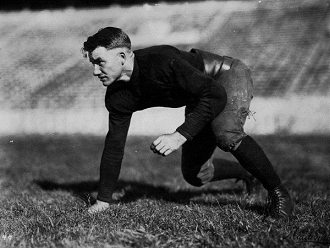
Nebraska
had won 12 conference championships in 17 years prior to this season,
but even though they beat Missouri this year, Missouri was technically
the Missouri Valley conference champion because they went 5-1 in
conference play, and Nebraska went 3-1. Because the Missouri Valley was
weak, and Nebraska was a nationally known power, the Cornhuskers tended
to be more interested in nationally relevant intersectional games than
in conference play. This year they played Illinois, Colgate, Notre
Dame, and Oregon State.
The coach was Princeton grad Fred
Dawson. He went 23-7-2 at Nebraska 1921-1924, winning conference titles
in each of his first 3 seasons, but his other coaching stops were not
so strong, and he finished but 52-45-10 for his career.
Nebraska's
star player this season was Hall of Fame tackle Ed Weir (pictured). He
combined speed and power, and was the conference champion in the high
hurdles. He had been a one-man defensive wrecking crew in a 14-7 win
over Notre Dame in 1923, the Four Horsemen's only loss that season,
prompting Knute Rockne to call him the greatest tackle he ever saw.
Weir was a consensus All American this season and next. In 1925,
Nebraska beat Grange and Illinois, and they beat Notre Dame again.
Years later, Weir was invited to a Four Horsemen reunion in New York
City. Sports Illustrated named him to their list of greatest players
1900-1950.
Weir won an NFL title in 1926 and was All-Pro in
1927. He returned to Nebraska as track coach 1939-1954 and won 10
conference titles. Ed Weir Stadium, for track meets, is named for him.
Pittsburgh, Chicago, and Syracuse
As
covered above, 8-2-1 Syracuse should be ranked behind 5-3-1 Pittsburgh,
so let's talk about Chicago. Chicago and their legendary
coach, Amos Alonzo Stagg, were greatly esteemed by the football press.
They certainly would have been rated higher than 5-3-1 Pittsburgh, but
I just can't see a good reason for that.
Chicago tied #11 Illinois, a
terrific result, but they also tied 2-3-3 Ohio State and 2-3-3
Wisconsin in their finale at home. In addition, they struggled to get
by 4-4 Northwestern 3-0 at home in their next-to-last game. Pitt's one
loss to an unrated team (5-4 Carnegie) equated to Chicago's 2 ties with
unrated teams, but Pitt's win over #10 West Virginia outdid Chicago's
tie with #11 Illinois. And unlike Chicago, Pitt did not have a close
win over an unrated team.
Chicago can, however, be rated higher
than 8-2-1 Syracuse. It's not clear which team an AP poll would have
preferred in 1924, but I think it would have been Chicago. And
Chicago's tie with #11 Illinois was much better than anything Syracuse
accomplished. Syracuse's big accomplishment, in fact, was their tie
with Pitt. And Chicago's upset ties came to better teams (2-3-3 Ohio
State and 2-3-3 Wisconsin) than Syracuse's upset loss came to (9-3
minor team West Virginia Wesleyan, who lost to Fairmont State and
Waynesburg).
Pittsburgh #22, Chicago #23, and Syracuse #24.
#25: Hawaii vs. Columbia
Here we go again. In 1925,
10-0 Hawaii fell just short of making the top 25, and once again, while
I'd love to give a token top 25 slot to this 8-0 Hawaii team, I just
can't give it to them over 5-3-1 Columbia. Hawaii won all of their
games by more than a touchdown, and they beat 8-1-1 Colorado 13-0. But
the Rocky Mountain region wasn't worth much, so Hawaii just didn't
accomplish much. Columbia took an upset loss to an unrated team, 4-4
Cornell, but Cornell was a much better team than anyone Hawaii even
played. Columbia also tied #8 Army, which blows away all of Hawaii's
wins put together. Columbia lost at #9 Penn just 10-7, and to #24
Syracuse 9-6. Like Hawaii, all of their wins came by more than a
touchdown, including a 27-3 victory over 7-1 Williams. Williams was a
minor team, but they beat 4-4 Cornell, and unlike Hawaii's best
opponent, they did not take any upsets (Colorado was tied by 4-2-2
Denver).
Columbia takes slot #25. Hawaii is unfortunately denied again.
Columbia
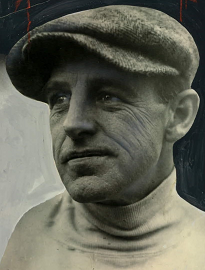
Columbia
had been a top 25 caliber football program early in the 20th century,
but they dropped football after 1905 amid national concerns over the
safety of the sport. They started playing again in 1915, but it was
hard catching up. They made a huge move toward that end in 1923 with
the hire of Hall of Fame coach Percy Haughton (pictured). Haughton had
been the coach at Harvard when they dominated the sport 1908-1916. He
went 71-7-5 there and won 4 MNCs. At Columbia he went 4-4-1 in 1923,
then had them off to a great 4-1 start this season when tragedy struck.
Following Columbia's 27-3 win over 7-1 Williams, he suffered an angina
attack on the field, and he died 2 days later. Assistant coach Paul
Withington finished the season as head coach, going a disappointing
1-2-1, though obviously I have Columbia holding on to the last spot in
the 1924 top 25 anyway. Haughton was 96-17-6 for his career, which ranks him highly on the list for
all-time
major/FBS coaching win percentage.
Columbia's star
player was Hall of Fame halfback Walter Koppisch, a nonconsensus All
American this season. In a 40-0 win over NYU, he ran for touchdowns of
76, 67, and 55 yards in one quarter.
Others
Receiving Votes
Here
are the teams closest to making this top 25.
Hawaii 8-0
As discussed
above, 8-0 Hawaii won all their games by more than a touchdown,
including a 13-0 victory over 8-1-1 Colorado. They would go unbeaten
and untied again in 1925, and again end up just outside the top 25.
Georgia 7-3
7-3 Georgia lost
just 7-6 at #3 Yale and 14-7 at #16 Centre, but their 33-0 loss at #17
Alabama was not so strong a performance. They repeatedly struggled with
unrated teams, 3-0 at 6-3-1 Vanderbilt, 7-0 at 5-4 Virginia, and 6-0
over 4-4-1 Auburn in Columbus, but those were all major teams, and I'm
thinking that Georgia would actually have been more deserving of a top
25 slot than Hawaii was.
Rutgers 7-1-1
Rutgers was a
minor or mid-major program at this time. They appeared to be headed for
the big time for much of this season, pulling off a 10-0 win over 4-0
Cornell, and better, an incredible 43-7 beatdown of #15 Lafayette. But
alas, 7-1-1 Rutgers took a tie at 4-1-3 Lehigh (discussed next), and
worse, a 12-7 loss to 8-2 Bucknell in their finale. Bucknell was a good
mid-major team this year, but they were routed by Lafayette and lost to
Dickinson, and Rutgers was the only good team they beat. It's the loss
to Bucknell, and the timing of it, that keeps Rutgers out of the top 25.
Lehigh 4-1-3
4-1-3 Lehigh
took their loss 7-0 at #15 Lafayette. They tied #19 Princeton, 7-1-1
Rutgers (covered above), and 7-1-1 Holy Cross. Holy Cross was a minor
team that lost to 4-4 Harvard and did not beat anyone of value, so
that's the tie that hurts. Lehigh didn't beat anyone of value
themselves, and they struggled to get by Muhlenberg and Villanova.
Williams 7-1
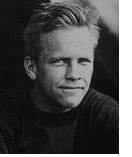 7-1 Williams was
another minor team that had a strong year. They were routed 27-3 by #25
Columbia, but they won 14-7 at 4-4 Cornell (who beat Columbia). Their
only other close game was a 13-6 win over Union.
7-1 Williams was
another minor team that had a strong year. They were routed 27-3 by #25
Columbia, but they won 14-7 at 4-4 Cornell (who beat Columbia). Their
only other close game was a 13-6 win over Union.
This
season's competitiveness was not a first for Williams. They would have
made a top 25 four or five times 1901-1914. But those days were gone,
and the only other time Williams would come this close to making the
top 25 after 1914 would be 1935.
The
coach was Percy Wendell (pictured), a Hall of Fame halfback at Harvard
1910-1912, where he had been a part of 2 MNC teams. He had gone 4-3-1
as a coach at Boston University in 1920, and at Williams he had a
terrific stint 1921-1924, going 25-6-1, including 7-1 campaigns in each
of his last 2 seasons. Lehigh hired him away after this season, and he
went a rather poor 5-20-2 in 3 seasons there to wind up his short
coaching career at 34-29-4.
In Wendell's one loss this season,
at Columbia, he was facing his former coach at Harvard, Percy Haughton,
who unfortunately suffered a fatal angina attack on the field after the
game (as detailed in the Columbia section above).
1924
Top 25
1) Notre Dame 10-0
2) California 8-0-2
3) Yale 6-0-2
4) Dartmouth 7-0-1
Stanford 7-1-1
6) St. Mary's (California) 8-1
7) Southern Cal 9-2
8) Army 5-1-2
9) Pennsylvania 9-1-1
10) West Virginia 8-1
11) Illinois 6-1-1
12) Iowa 6-1-1
13) Michigan 6-2
14) Washington 8-1-1
15) Lafayette 7-2
16) Centre 5-1-1
17) Alabama 8-1
18) Washington & Jefferson 7-2
19) Princeton 4-2-1
20) Nebraska 5-3
21) Missouri 7-2
22) Pittsburgh 5-3-1
23) Chicago 4-1-3
24) Syracuse 8-2-1
25) Columbia 5-3-1
Others
Receiving Votes:
Hawaii 8-0
Georgia 7-3
Rutgers 7-1-1
Lehigh 4-1-3
Williams 7-1
 Army
was coached by John McEwan, a Hall of Fame center at Army 1913-1916,
during which time they had won 2 MNCs. He was also a good coach. He
went 18-5-3 here 1923-1925, 20-13-2 at Oregon 1926-1929, and 21-5-1 at
Holy Cross 1930-1932, for an overall record of 59-23-6.
Army
was coached by John McEwan, a Hall of Fame center at Army 1913-1916,
during which time they had won 2 MNCs. He was also a good coach. He
went 18-5-3 here 1923-1925, 20-13-2 at Oregon 1926-1929, and 21-5-1 at
Holy Cross 1930-1932, for an overall record of 59-23-6.

 Penn
had been a football elite 1892-1910. Hall of Fame coach George Woodruff
went 124-15-2 there 1892-1901 and won 3 MNCs. He ranks very highly on the list for all-time
major/FBS coaching win percentage. After he retired, Penn was a top 10 caliber team
7 straight years 1904-1910 and won 2 more MNCs. Things dropped off a
bit in the next decade, but they were still a #11-20 type team
1911-1919. Then John Heisman arrived in 1920 to restore Penn to their
former glory. Except he didn't. He went 16-10-2 1920-1922, another step
backward. His assistant coach, Penn grad Lou Young, succeeded him and
improved matters, going 49-15-2 1923-1929. His best seasons were this
9-1-1 campaign, 7-1-1 in 1926, and 8-1 in 1928.
Penn
had been a football elite 1892-1910. Hall of Fame coach George Woodruff
went 124-15-2 there 1892-1901 and won 3 MNCs. He ranks very highly on the list for all-time
major/FBS coaching win percentage. After he retired, Penn was a top 10 caliber team
7 straight years 1904-1910 and won 2 more MNCs. Things dropped off a
bit in the next decade, but they were still a #11-20 type team
1911-1919. Then John Heisman arrived in 1920 to restore Penn to their
former glory. Except he didn't. He went 16-10-2 1920-1922, another step
backward. His assistant coach, Penn grad Lou Young, succeeded him and
improved matters, going 49-15-2 1923-1929. His best seasons were this
9-1-1 campaign, 7-1-1 in 1926, and 8-1 in 1928.

 7-1 Williams was
another minor team that had a strong year. They were routed 27-3 by #25
Columbia, but they won 14-7 at 4-4 Cornell (who beat Columbia). Their
only other close game was a 13-6 win over Union
7-1 Williams was
another minor team that had a strong year. They were routed 27-3 by #25
Columbia, but they won 14-7 at 4-4 Cornell (who beat Columbia). Their
only other close game was a 13-6 win over Union